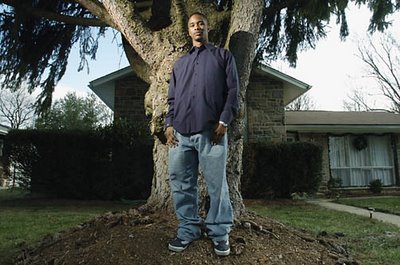 When last we met, we talked about the idea of balancing strobe with ambient. We were using the strobe as a main light and the ambient as fill, but you do not always have to do it that way.
When last we met, we talked about the idea of balancing strobe with ambient. We were using the strobe as a main light and the ambient as fill, but you do not always have to do it that way.Straight fill flash is very simple these day, with TTL flashes doing the heavy lifting for you automatically. But doing it the easy way usually means keeping the light on the camera, or using a TTL cord. These little cords tend to make the light come from a consistent position on the left side of the frame because that's where Darwin stuck your left hand.
The goal here is to start to replace the concept of 'fill flash' with that of 'balancing light.' And, more importantly, to separate the ideas of fill flash fill/balance from the rote use of on-camera flash.
 The process of using flash to augment (which is a better concept than fill) sunlight is very straightforward. First you are going to start at your camera's highest synch speed, because that'll get you the most flexibility from your small flash. While you're at it, dial your ASA down as low as it will go to get better quality and avoid those CCD-chip dust spots, too.
The process of using flash to augment (which is a better concept than fill) sunlight is very straightforward. First you are going to start at your camera's highest synch speed, because that'll get you the most flexibility from your small flash. While you're at it, dial your ASA down as low as it will go to get better quality and avoid those CCD-chip dust spots, too.Now think about your lighting angle. As opposed to the idea of fill flashing, on-camera, from any angle outside without regard to the sun's direction, using a strobe on a stand effectively gives you two lights to play with. You can balance. You can cross light, You can do both. You'll have more flexible (and consistent) results using this approach.
When you just fill flash from on-camera, it does bring up the shadows. But while the flash adds detail it really misses out on the opportunity to improve the depth and quality of the light. So why not do both at the same time?
Step one: Think of the sun as your main light, and your strobe as a secondary light. You are not just getting rid of raccoon eyes now. You are working with two lights. You have flexibility.
Choose your angle of attack. Maybe you have the sun behind you (on the left side) at a ~45-degree angle. Why would you have your fill on on camera when it would look better lighting from the upper right? On camera flash limits you. All the time.
Maybe you turn the angle around and shoot the subject in profile. Say he is facing to your right. You could have him looking into the sun, which is now angled to come from slightly behind his face to provide nice (but too contrasty) rim light. Just move your strobe over to the left side, elevate it a little, and you have a cool-looking, two-light setup.
Whatever the angle, the technique for balancing is the same. We are basing the exposure on the ambient this time, and bringing the flash up to fill shadows and/or provide light from another direction.
Assuming a sunny ambient to balance, set your camera at the highest synch speed (i.e. lowest aperture) to ease the burden on your flash. Now, get your base (ambient) exposure. We'll call it a 250th at f/11 at ASA 200 for the sake of argument.
Now, with your strobe on manual and on a stand, set it to somewhere around a quarter to half power if you are working close. Maybe half to full power if the flash is further away. If you are not lighting a large area (and you usually are not) zoom the flash to a 70mm or 85mm lens angle to make it even more powerful.
Pop a test frame and eyeball it. If your flash-lit area is too bright, dial the flash down or move it back. If it is too dark, dial it up or move it forward.
This is a fast, simple technique that works great. No flash meter needed. Full manual for a consistent shoot.
The important thing to remember (and why I told you the angle stuff first) is that this is now a starting point to turn your outside "fill" strobe into a true, useful second light source. Experiment.
One of the most useful
Outside? Play with fill light and angles. (You might want to grab something safe in the shade first just in case.)
Inside? Set up a quick umbrella in a corner where one wall is your background and another is your fill card.
You'll turn a mug shot into a head shot, which is just a more professional way to do it. You'll get some good (low-pressure) experience in your lighting. And they'll look better in the paper. It's a win-win.
And, contrary to what you might think, most people will be secretly flattered by the effort you are putting in to making a better photo of them.
And one more thing. Stop thinking of them as mug shots from this point forward. A
Next: Using Gels to Correct Light
No comments:
Post a Comment